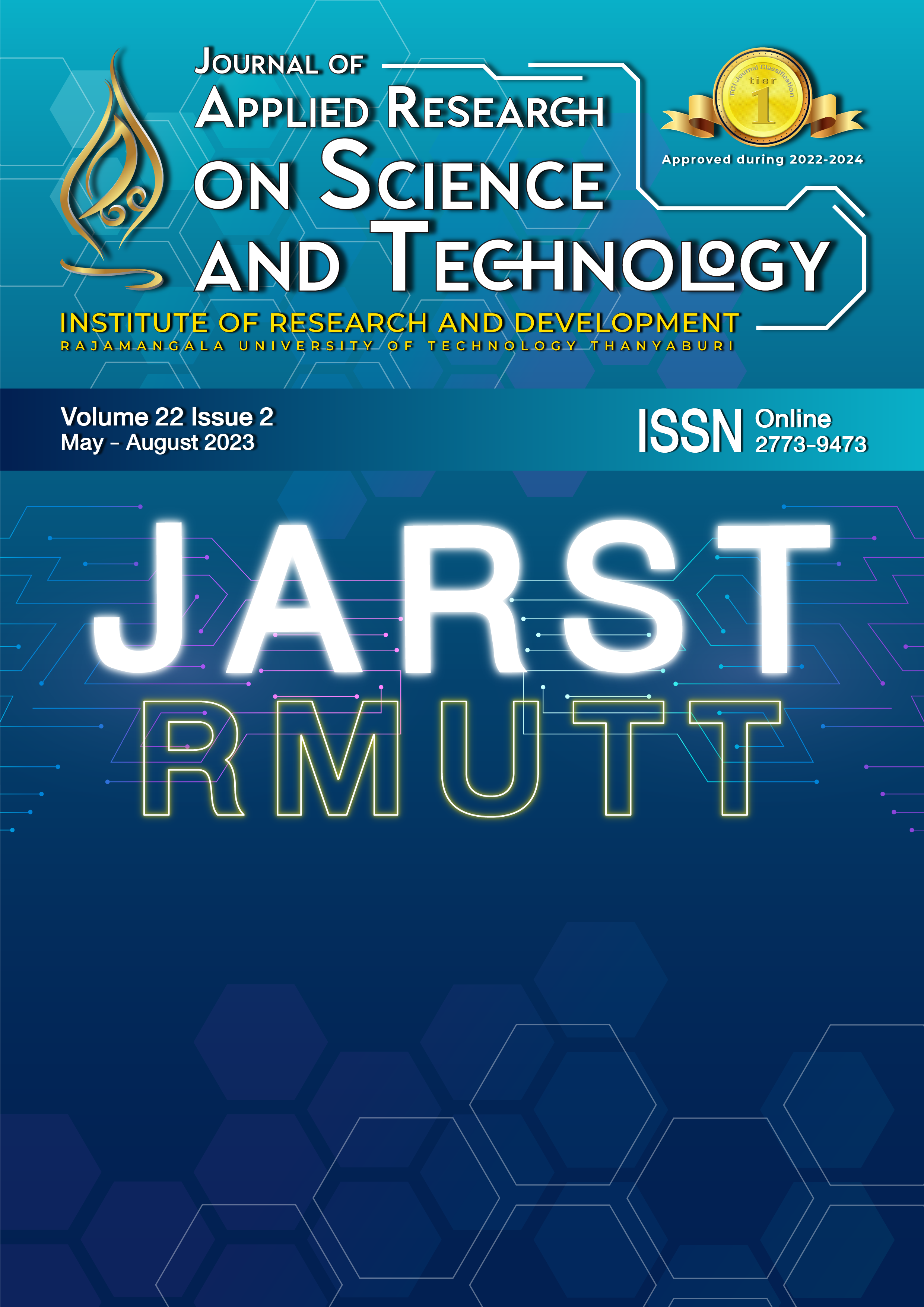Extraction of natural dye from Oroxylumb indicum (L.) Kurz by using different solvents for Thai eri silk dyeing
Main Article Content
Abstract
Among various textile types in Thailand, silk is the largest market share. Thus, upgrading or developing either the dying process or the quality of fabric dried for Thai silk is still necessary. Natural dyes have become an interesting resource because they are more environmentally friendly than synthetic dyes. Thus, this work aims to study the effect of different solvents for dye extraction from Oroxylumb Indicum (L.) Kurz on Eri Thai silk dyeing. Each solvent used for extraction gave a different relative tannic acid and quercetin content. Therefore, this further leads to different properties of dyed fabrics, such as color properties and washing fastness index. From the different solvents studied, the yield of the extracted dyes was on the order of EtOH/water (50: 50) > MeOH/water (50:50) > MeOH ~ EtOH > water. Then, the optimal ratios between EtOH and water in the efficient extraction were varied as follows water, EtOH/water (25: 75), EtOH/water (50: 50), EtOH/water (75:25), and EtOH. The result showed that EtOH/water (50: 50) was still the most effective for dye extraction. In addition, the effect of dose, temperature, and time of Oroxylumb Indicum (L.) Kurz was 8.0 g/L, 60 °C, and 60 min, which were considered optimal extraction conditions due to the high relative contents of tannic acid and quercetin. As a result, the fabric of Eri silk dyed has a high quality of fastness rating. Overall, these results could point out the use of extracted dye from Oroxylumb Indicum (L.) Kurz has the potential as an alternative dye for Eri Thai silk dyeing.
Article Details

This work is licensed under a Creative Commons Attribution-NonCommercial-NoDerivatives 4.0 International License.
References
Graham M. Justifying virtual presence in the thai silk industry: Links between data and discourse. Inf Technol Int Dev. 2010;6:57–70.
Patichol P, Wongsurawat W, Johri LM. Upgrade strategies in the Thai silk industry: Balancing value promotion and cultural heritage. J Fash Mark Manag. 2014;18:20–35.
Lellis B, Fávaro-Polonio CZ, Pamphile JA, Polonio JC. Effects of textile dyes on health and the environment and bioremediation potential of living organisms. Biotechnol Res Innov. 2019;3;275–90.
Kulawong S, Chanlek N, Osakoo N. Facile synthesis of hierarchical structure of NaY zeolite using silica from cogon grass for acid blue 185 removal from water. J Environ Chem Eng. 2020;8:104114.
Adedokun O, Sanusi YK, Awodugba AO. Solvent-dependent natural dye extraction and its sensitization effect for dye sensitized solar cells. Optik (Stuttg). 2018;174:497–507.
Adeel S, Rehman FU, Rafi S, Zia KM, Zuber M. Environmentally friendly plant-based natural dyes: Extraction Methodology and Applications. In: Ozturk M, Hakeem KR, editor. Plant and Human Health, Volume 2. Eswatini: Springer Nature Switzerland AG; 2019. p. 383–415.
Dulo B, De Somer T, Phan K, Roosen M, Githaiga J, Raes K, et al. Evaluating the potential of natural dyes from nutshell wastes: Sustainable coloration and functional finishing of wool fabric. Sustain Mater Technol. 2022;34:e00518.
Bukhari M, Shahid-ul-Islam N, Shabbir M, Rather LJ, Shahid M, Singh U, et al. Dyeing studies and fastness properties of brown naphtoquinone colorant extracted from Juglans regia L on natural protein fiber using different metal salt mordants. Text Cloth Sustain. 2017;3:1-9.
Yusuf M, Shahid M, Khan MI, Khan SA, Khan MA, Mohammad F. Dyeing studies with henna and madder: A research on effect of tin (II) chloride mordant. J Saudi Chem Soc. 2015;19:64–72.
Banerjee AN, Kotnala OP, Maulik SR. Dyeing of Eri silk with natural dyes in presence of natural mordants. Indian J Tradit Knowl. 2018;17:396–9.
Rossi T, Silva PMS, De Moura LF, Araújo MC, Brito JO, Freeman HS. Waste from eucalyptus wood steaming as a natural dye source for textile fibers. J Clean Prod. 2017;143:303–10.
Rehman R, Mahmud S, Habib MA, Islam A. Revolution of Silk Dyeing with FL Based Cotton-Reactive Dyes. Int J Text Sci. 2015;4:42–52.
Łabowska MB, Michalak I, Detyna J. Methods of extraction, physicochemical properties of alginates and their applications in biomedical field - A review. Open Chem. 2019;17:738–62.
Adedokun O, Sanusi YK, Awodugba AO. Solvent dependent natural dye extraction and its sensitization effect for dye sensitized solar cells. Optik. 2018;174:497–507.
Mongkholrattanasit R, Kryštůfek J, Wiener J, Viková M. UV protection properties of silk fabric dyed with eucalyptus leaf extract. J Text Inst. 2011;102:272–9.
Faraz R, Gokhale M, Gothalwal R. Callus extracts of Oroxylum indicum (L.) Vent containing baicalein have in vitro antioxidant and antibacterial activities. Biotecnol Veg. 2020;20:51–62.
Fu Z, Chen R. Study of complexes of tannic acid with Fe(III) and Fe(II). J Anal Methods Chem. 2019;2019:1-6.
Srinivas K, King JW, Howard LR, Monrad JK. Solubility and solution thermodynamic properties of quercetin and quercetin dihydrate in subcritical water. J Food Eng. 2010;100:208–18.
Ranoszek-Soliwoda K, Tomaszewska E, Socha E, Krzyczmonik P, Ignaczak A, Orlowski P, et al. The role of tannic acid and sodium citrate in the synthesis of silver nanoparticles. J Nanoparticle Res. 2017;19:1–15.
Porto ICCM, Nascimento TG, Oliveira JMS, Freitas PH, Haimeur A, França R. Use of polyphenols as a strategy to prevent bond degradation in the dentin–resin interface. Eur J Oral Sci. 2018;126:146–58.
Jagetia GC. A Review on the Medicinal and Pharmacological Properties. Sinusitis. 2021;5:71–89.
Wettasinghe M, Shahidi F. Antioxidant and free radical-scavenging properties of ethanolic extracts of defatted borage (Borago officinalis L.) seeds. Food Chem. 1999;67:399–414.
Soares AT, Júnior JGM, Lopes RG, Derner RB, Filho NRA. Improvement of the extraction process for high commercial value pigments from desmodesmus sp. Microalgae. J Braz Chem Soc. 2016;27:1083–93.
Nugraha J, Sukmawati A, Mulyawan AS, Sugiyana D. Biduri (Calotropis gigantea) leaves extract as natural dyes and ultraviolet protector applied on silk fabric with an exhaust dyeing method. IOP Conf Ser Mater Sci Eng. 2020;980:012021.


